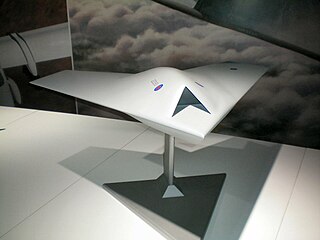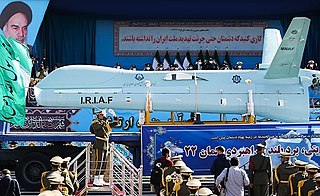A UAV is an unmanned aerial vehicle, commonly known as a drone.
UAV may also refer to:
A UAV is an unmanned aerial vehicle, commonly known as a drone.
UAV may also refer to:

An unmanned aerial vehicle (UAV), commonly known as a drone, is an aircraft without any human pilot, crew, or passengers on board. UAVs are a component of an unmanned aircraft system (UAS), which includes adding a ground-based controller and a system of communications with the UAV. The flight of UAVs may operate under remote control by a human operator, as remotely-piloted aircraft (RPA), or with various degrees of autonomy, such as autopilot assistance, up to fully autonomous aircraft that have no provision for human intervention.

An unmanned combat aerial vehicle (UCAV), also known as a combat drone, colloquially shortened as drone or battlefield UAV, is an unmanned aerial vehicle (UAV) that is used for intelligence, surveillance, target acquisition, and reconnaissance and carries aircraft ordnance such as missiles, ATGMs, and/or bombs in hardpoints for drone strikes. These drones are usually under real-time human control, with varying levels of autonomy. Unlike unmanned surveillance and reconnaissance aerial vehicles, UCAVs are used for both drone strikes and battlefield intelligence.

The Dassault nEUROn is an experimental unmanned combat aerial vehicle (UCAV) being developed with international cooperation, led by the French company Dassault Aviation. Countries involved in this project include France, Greece, Italy, Spain, Sweden and Switzerland. The design goal is to create a stealthy, autonomous UAV that can function in medium-to-high threat combat zones. Comparable projects include the British BAE Systems Taranis, German/Spanish EADS Barracuda, American Boeing X-45 and Northrop Grumman X-47B, the Indian DRDO AURA, and the Russian Mikoyan Skat and Sukhoi Okhotnik.

The history of unmanned combat aerial vehicles (UCAVs) is closely tied to the general history of unmanned aerial vehicles (UAVs). While the technology dates back at least as far as the 1940s, common usage in live operations came in the 2000s. UCAVs have now become an important part of modern warfare, including in the Syrian civil war, the 2020 Nagorno-Karabakh war and during the 2022 Russian invasion of Ukraine.
The Dassault LOGIDUC – sometimes spelled Logiduc in French and LogiDuc in English – was an autonomous industrial program launched in 1999 by the French aircraft manufacturer Dassault Aviation in view to develop its UAV design capacities. This French programme eventually led to the creation of the Dassault-Sagem Tactical UAV company and to the European "combat drone" project nEUROn.

The BAE Systems Taranis is a British demonstrator programme for unmanned combat aerial vehicle (UCAV) technology, under development primarily by the defence contractor BAE Systems Military Air & Information. The aircraft, which is named after the Celtic god of thunder Taranis, first flew in 2013. An unmanned warplane, the Taranis is designed to fly intercontinental missions, and would carry a variety of weapons, enabling it to attack both aerial and ground targets. It uses stealth technology, giving it a low radar profile, and is controllable via satellite link from anywhere on Earth.

An uncrewed vehicle or unmanned vehicle is a vehicle without a person on board. Uncrewed vehicles can either be remote controlled or remote guided vehicles, or they can be autonomous vehicles which are capable of sensing their environment and navigating on their own.

The Burraq is an unmanned combat aerial vehicle (UCAV) jointly developed and built by the National Engineering and Scientific Commission (NESCOM) and the Pakistan Air Force (PAF).

Ghatak is an autonomous jet powered stealthy unmanned combat air vehicle (UCAV), being developed by Aeronautical Development Establishment (ADE) of the Defence Research and Development Organisation (DRDO) for the Indian Air Force. The design work on the UCAV is to be carried out by Aeronautical Development Agency (ADA). Autonomous Unmanned Research Aircraft (AURA) was a tentative name for the UCAV. Details of the project are classified.

The Chengdu Pterodactyl I, also known as Wing Loong, is a Medium-Altitude Long-Endurance (MALE) unmanned aerial vehicle (UAV), developed by the Chengdu Aircraft Industry Group in the People's Republic of China. Intended for use as a surveillance and aerial reconnaissance platform, the Pterodactyl I is capable of being fitted with air-to-surface weapons for use in an unmanned combat aerial vehicle (UCAV) role. Based on official marketing material released by CADI, the Pterodactyl can carry the BA-7 air-to-ground missile, YZ-212 laser-guided bomb, YZ-102A anti-personnel bomb and 50-kilogram LS-6 miniature guided bomb.
The ASN UAV are a series of Chinese UAVs developed by Xi'an Aisheng Technology Group Co., Ltd (西安爱生技术集团公司)ASN Technology Group Co., Ltd (西安爱生技术集团公司), also known as Northwestern Polytechnical University UAV Research Institute or 365th Institute, established in 1984.

The Bayraktar UAV or Bayraktar UCAV is a family of unmanned aerial vehicles designed and manufactured by Turkish company Baykar. The UAVs were developed for the Turkish Armed Forces from 2004 until the present. Some models are designed for surveillance and reconnaissance only, others are capable of tactical ground-strike missions. Baykar is also developing drones to counter other aerial systems. The word bayraktar means flag-bearer in Turkish.

Adcom Systems is an Emirati unmanned aerial vehicle manufacturer based in the United Arab Emirates. It is made up of a group of 20 private companies.
A loitering munition is an aerial weapon system category in which the munition loiters around the target area for some time and attacks only once a target is located. Loitering munitions enable faster reaction times against concealed or hidden targets that emerge for short periods without placing high-value platforms close to the target area, and also allow more selective targeting as the attack can easily be aborted.

Baykar is a private Turkish defence company specialising in UAVs, C4I and artificial intelligence.

The Sukhoi S-70 Okhotnik-B, also referred to as Hunter-B, is a Russian stealth heavy unmanned combat aerial vehicle (UCAV) being developed by Sukhoi and Russian Aircraft Corporation MiG as a sixth-generation aircraft project. The drone is based on the earlier Mikoyan Skat, designed by MiG, and encompassing some technologies of the fifth-generation Sukhoi Su-57 fighter jet.

An unmanned surveillance and reconnaissance aerial vehicle, is an unarmed military UAV that is used for intelligence, surveillance, target acquisition, and reconnaissance (ISTAR). Unlike unmanned combat aerial vehicle (UCAV), this type of system is not designed to carry aircraft ordnance such as missiles, ATGMs, or bombs for drone strikes. The main purpose is to provide battlefield intelligence. Small sized short-range man-portable unmanned aerial vehicles are called miniature UAV also used for battlefield intelligence.

Kaman 22 (UAV) is an Iranian wide-body unmanned combat aerial vehicle (UCAV) unveiled on the 24th of February, 2021 by the Islamic republic of Iran Air Force. It is said to be the country's first wide-body drone. The range of the Kaman 22 is approximately 3,000 km (1,900 mi) and it can carry 300 kg (660 lb) of explosives.

AVIC 601-S is an unmanned aerial vehicle development program containing series of Chinese low-observable flying wing UAVs jointly developed by Shenyang Aircraft Design Institute (SYADI) of Aviation Industry Corporation of China (AVIC) and Shenyang Aerospace University (沈阳航空航天大学). The name 601-S derives from the names of the developers: SYADI of AVIC is also widely known as the 601st Institute, hence 601, and the letter S is for Shenyang Aerospace University (SAU). A total of seven different models have been identified as of 2013.